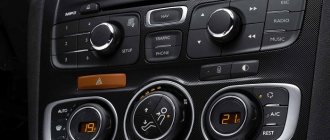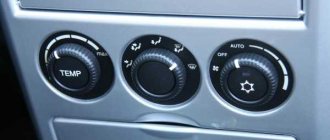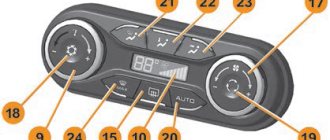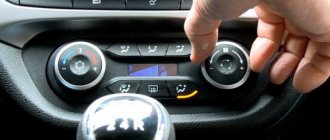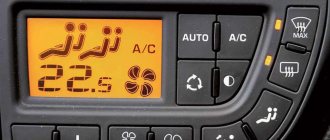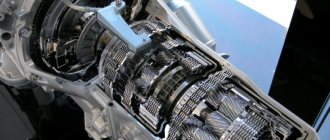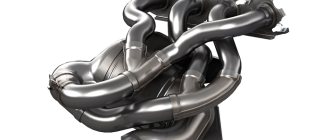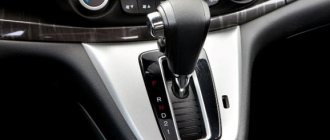Climate control system in the car provides comfort and convenience for the driver and passengers. Its main difference from an air conditioner is that it constantly maintains the specified climatic conditions. The system can be single- or multi-zone. Due to its complexity during operation, car owners may have a number of questions, in particular: “How to use the climate control? What to do, if Climate control does not turn on? How to conduct climate control cleaning? We will try to talk about this and much more in detail.
What is climate control in a car?
Automotive climate control (hereinafter referred to as CC) is a system consisting of an air conditioner, a heater, temperature and humidity sensors, a filtration system and an electronic control unit. The purpose of the system is to maintain the microclimate inside the car, regardless of the weather outside.
The operating principle of climate control is simple. It is based on the operation of an electronic feedback processor, which receives information from numerous sensors that record the temperature in different parts of the car interior. The user sets the desired temperature parameters in the control unit. And the processor supports them all the time, based on information from the sensors, and, if necessary, adjusting the operation of the cooling or heating systems.
The climate control device is fundamentally similar to stationary split-systems with feedback used in various rooms.
Interestingly, the climate control includes not only an air conditioner, but also a heater. Therefore, the system can also be used in winter to heat the interior. In addition, the air conditioner and heater dry the air passing through them. This makes it possible to prevent car windows from fogging up . In more advanced systems, the processor also takes into account the effect of sunlight on the interior temperature (the so-called ultraviolet sensor).
Sometimes there are even more sophisticated options. For example, some Infiniti models have an air ionizer.
Another feature of car climate control is the ability to recirculate air in the car if the outside air is too polluted. This is ensured by monitoring the filtration system. If the degree of air pollution exceeds the permissible norm, then the climate control does not take air from outside, but repeatedly rotates the air volume located in the car’s cabin. As a rule, this happens automatically.
Auto mode
When the climate system is turned on, by default it starts operating in automatic mode, which involves distributing the air flow in such a way as to ensure that the temperature is maintained at a given level, separately for the left and right sides of the cabin. If while driving the car the operating parameters of the climate system were set that differed from the original ones, you can return to them by pressing the “AUTO” button (the yellow LED built into the button will light up). The desired zone temperature is set using the corresponding rotary controls. The manufacturer recommends maintaining a value of 22° C (72° Fahrenheit) - this temperature is considered the most comfortable for everyone present in the car.
This indicator is changed if for some reason this temperature does not suit the driver or passengers. It should be noted that climate control allows you to set the temperature within 16 - 29.5 degrees Celsius (61 - 86 degrees Fahrenheit), and these values are conditional - depending on external factors, they may shift slightly to one or another side.
Automatic maintenance of a given microclimate is carried out by controlling the rate of air flow into the cabin, distributing warm and cold air to obtain a given temperature, and also by regulating the direction of airflow. Climate control is able to interpret the amount of solar radiation, accordingly changing the operating parameters of the climate system. This is facilitated by installing a solar radiation sensor. The automatic mode is turned off by pressing any of the control buttons, including the “ECON” button. But this does not mean that the climate control ceases to maintain the specified operating parameters - it is simply considered that new values have been set that will remain the same when the ignition is turned off after the car is stopped.
Types of climate control and their features
Climate control systems are divided according to different criteria - the presence of separate work zones, power, ease of control, and the presence of additional functions. First, let's talk about single- and multi-zone systems.
Operation of a multi-zone QC system
Today, single-zone, dual-zone, three-zone and four-zone climate controls . What is it and how are they different? Single-zone climate control is the simplest of the systems presented. It is designed according to the principle described above and controls the air parameters in the driver and front passenger area. Dual-zone climate control divides the air space between the driver and front passenger, respectively, into two parts, for which different climate parameters can be set. This provides additional convenience. Three- and four-zone systems also allow you to set individual climate parameters for rear passengers. The last option is considered the most advanced and comfortable.
Now a few words about the differences between climate control systems and the car air conditioning that is familiar today. Let's start with the last one. It performs two functions - it cools the air and dehumidifies it. That is, this device has no feedback. The driver must independently regulate the temperature supplied by the air conditioner in real time. And this is not always convenient. The main difference between climate control is precisely the presence of feedback, which is needed to maintain user-specified parameters on an ongoing basis.
The simplest single-zone climate control can operate in the following modes of automatic supply of cooled or heated air:
- legs;
- head;
- head/legs;
- windshield/legs;
- windshield (in this case, as a rule, the air is additionally dried to prevent fogging).
Multi-zone climate control systems have additional, more advanced operating modes for distributing air in the cabin.
general information
Climate control is a modern technological system that provides the highest possible comfort for the driver and passengers. The main task of this equipment is to maintain the most comfortable air temperature in the cabin throughout the entire trip.
Operating principle
The main principle of operation is to maintain optimal temperature conditions using air conditioning and heating systems. To obtain information about the temperature in the cabin, there are sensors capable of transmitting the necessary information to the control unit.
Next, a signal goes from the control unit to certain actuators, such as a temperature damper. The entire process of adjusting and retrieving information from sensors is performed fully automatically.
Main components of the system
The above system consists of the following elements:
Control block. It is the “brain” center of this system and processes incoming signals and sends commands to the main devices. Sensors They are located inside the cabin and monitor the state of the main climate parameters in the cabin. Most car models are equipped with the following sensors: temperature, solar, and vehicle status. Executive devices. Carry out the task coming from the control unit. For example, to increase the volume of air flow, a signal is sent to the electric sensor of the fan. Damper. Used for the normal functioning of the entire system
The damper is a very important part that regulates the distribution of warm and cold air flow inside the car. There are several types of dampers: • central, used for basic air temperature control; • recirculating, which function to regulate the intensity of air flow; • for supplying air from the environment; • for blowing glass.
Climate control system design
Climate control consists of a large number of devices. In particular:
- Electronic control unit . This is perhaps the most important part of the system, its “brain”. It includes a controller with control programs and an information input system. These can be mechanical or electronic regulators. As a rule, information is entered into modern control units digitally, including using a remote control. Based on the incoming information, the controller program controls the executable devices - the fan rotation speed, the position of the dampers, and issues a command to increase or decrease the temperature of the blown air.
- Sensors _ They are located both inside the car and on the outside. Internal sensors monitor climate indicators in the areas where they are installed. There is also a separate temperature control sensor at the heater/cooler outlet. Interior sensors usually have forced airflow so that they provide information as quickly as possible. The more complex the system (multi-zone), the greater their number. External sensors are designed to monitor the temperature and air pollution outside the vehicle.
- Actuators . There are many devices that fall into this category. In particular, cooling and heating devices (air conditioner and stove), air dampers and their drive motors, air ducts, fans, filters, deflectors, and so on.
Components of the climate control system
It is not at all necessary for the driver to thoroughly know the internal workings of climate control. It is much more important to know the symbols on the climate control control knobs and how to configure the parameters. And also understand what preventive measures to take in order to keep the system in working order.
What are the Econ and Sync buttons?
Some vehicles' climate control systems contain Econ and Sync buttons. There are quite a lot of myths among motorists about their purpose. Features of operating modes:
- Econ is an economical mode that forcibly regulates or turns off the compressor when the button is activated. In some cars, the air conditioner continues to operate, but the engine speed does not increase, which saves fuel.
- Sync is a special option for synchronizing temperature conditions in different areas of the cabin. Used exclusively in climate control systems that consist of two or more zones.
Climate control
How to use climate control
Different vehicles may use different controls to operate the climate control. But as a rule, the designations on them are standardized. Below we provide up-to-date information.
Review of dual-zone CC control on a Ford Focus 3
How to turn on climate control? Typically, a button with the words ON/OFF or an image of a broken circle is used for this. To turn on the air conditioner, use the button labeled A/C. The temperature in the general or separately in each zone is set using buttons or a rotary controller (roller). As a rule, the adjustment step is 0.5°C. The maximum difference between individual zones is 4...5°C. The AUTO button allows you to directly activate the system so that it automatically maintains the set temperature.
Also, in any climate control unit there are several buttons that indicate the direction of air movement. The minimum number is three. This is blowing the legs, blowing the head and legs, and blowing the windshield. Often there are more modes.
The CC control algorithm is basically the same for everyone; it all comes down to setting the required temperature with a knob or buttons and setting the blowing area. But still, different cars may have their own nuances, so it is better to find how to use climate control in the manual for your car or directly in the climate control operating instructions.
The air conditioning and climate control systems operate most efficiently at high engine speeds. Therefore, after turning them on, it makes sense to switch to a lower gear, while increasing the speed. When the temperature becomes comfortable, you can drive in optimal mode.
It is recommended to check the refrigerant system for leaks at least once a year. If necessary, refrigerant is added to the system. This needs to be done in a special service. It is also advisable to do diagnostics of the electronic unit there.
An example of button designations on the climate control control panel in Volkswagen cars
One more tip. The climate control system (like the air conditioner) must be turned on no earlier than one minute after starting the engine . And at the end of the trip it’s the other way around. Turn off the air conditioner at least one minute before stopping the engine.
The difference between the air temperature outside the car and inside the car should not exceed 10°C. Otherwise there is a risk to your health.
How does an air conditioner work?
Since recently there has been a rise in fuel prices and an economic crisis, many car enthusiasts are in favor of abolishing the use of car air conditioners. There are many recommendations for overall energy savings, and the use of integrated factory cooling is one of the main factors for poor fuel economy.
Opponents of air conditioners recommend using traditional ventilation, which is air entering through the window. Of course, this version is very impractical, especially in winter, when an open window can cause flu and inflammation. However, to choose the solution that's best for you, you should first consider the most common advantages and disadvantages of using air conditioning in your car.
Actively cooling the cabin with air conditioning can increase overall gasoline consumption by 10%. Research has shown that opening windows for ventilation when driving at an average speed of 70 km/h (or lower) will provide your car with maximum efficiency in terms of fuel consumption and comfort.
In most standard situations (driving around town, going to the mall, meeting with friends or relatives), it is easiest to always ventilate the car with natural air, unless the environment and temperature will cause you discomfort or affect the proper functioning of the vehicle. This way, from spring to fall, you can keep your car windows open when the heat allows, while keeping fuel consumption as low as possible.
Let's start with the refrigerant (r134a) inside the system. This refrigerant was specifically created for the automotive industry in the late 1980s and is somewhat different from household or industrial refrigerants. Some call it "Freon".
Some of the gas is held under pressure within the system. When the system is not operating, the refrigerant remains a gas under low pressure. The optimal property of the gas is its ability to come out of a hot state when it is compressed, and when cooled in a condenser located in front of the radiator, it turns into a pressurized liquid, which is then released through an expansion valve or diaphragm (small hole). The high-pressure liquid instantly turns into low-pressure vapor, which creates cold inside the evaporator, in which case the fan motor forces air through it into the ventilation system and into the inside of the machine.
The evaporator core looks like a small radiator that is located inside the car. Once the refrigerant has used up its cold charge, it is collected in a low pressure hose and to the compressor where it is processed again. Refrigerant is transferred from one component to another using hoses or pipes. The high pressure side hose connects the compressor to the condenser, from the condenser to the expansion valve or vented tube that is located in front of the evaporator. The low side connects the evaporator to the compressor. An expansion valve or diaphragm does essentially the same job, and the system may have one or the other. The expansion valve can be of different sizes depending on the temperature, while the diaphragm has a fixed size.
Car air conditioner
When is it good to use air conditioner?
If you exceed the speed of 70-80 kilometers per hour, as is usually the case on long trips to another city, it is better to keep the windows closed and use the air conditioning system. Open windows will increase fuel consumption by as much as 20%. Strong airflow slows the car down and makes it even more unstable, not to mention clunky to handle. But driving quickly with the windows closed is uncomfortable, so when driving at higher speeds, it is recommended to use air conditioning.
In addition to air conditioning, there are other solutions that allow you to ventilate your car and maintain comfort inside it. Firstly, the main fan of the car, if it is vented into the passenger compartment, can ventilate the car quite well and reduce its temperature. It can also change the smell in the car, namely, get rid of fuel or street “aroma”. It's best to use this setting to its maximum, but you can choose less intense settings if you prefer.
Another very simple way is to park your car in a parking lot or in a cool place in the shade. On a hot day you will benefit in terms of comfort and fuel consumption will be reduced.
Installation of climate control
Some car owners whose cars are not equipped with a climate control system decide to install it additionally. This task requires spending a lot of time, money and effort. In addition, you need to know that the QC system may not be installed on every machine. After all, the fact is that the stove must be of a certain design so that it is possible to install various servos and wiring under the “dashboard”.
But if you still decide to install an additional climate control system on your own or with the help of specialists, then you will need the following list of devices and assemblies (may differ for different cars):
- electrical wiring from a similar car that has a climate control system (this is a whole wiring harness);
- a stove that was installed on a similar machine with a CC system, and working servos must be attached to it;
- two temperature sensors installed in the stove pipe;
- two temperature sensors installed in the central air ducts;
- solar radiation sensor (may not be part of the CC system);
- fan sensor with a cover-mount (the cover is usually very difficult to find); frame;
- control unit (the only element that is widely available).
Often, when installing a system, it is necessary to change the factory “torpedo” of the car. For this, different methods and materials are used. For example, fiberglass, from which additional elements are made for attaching CC controls. Work must be performed carefully so as not to damage factory elements.
The stove doesn't heat well
Car owners begin to notice that the stove is not heating well only with the arrival of cold weather, although the reasons for poor performance arise much earlier. Most often, the stove in a car heats poorly due to: airing, a faulty pump, a clogged radiator and cabin filter Read more
Car heater and care
A car heater is a heater radiator with the entire system as a whole. Periodic maintenance is required for proper functioning. The list of required work includes: checking, cleaning and replacing the cabin filter Read more
Diagnostics, repair and refilling of car air conditioning
A visual guide to car air conditioning maintenance and repair will help you properly maintain your car's air conditioner. Diagnostics are carried out not only when refilling freon, but also every seasonal maintenance.
What to do when climate control does not work
Self-diagnosis of climate control on Nissan Tiida
The QC system, like any mechanism, can fail. Let's take a closer look at how to independently diagnose climate control . Let’s immediately make a reservation that different machines and systems may have their own specifics, and even more so the decoding of their errors. As an example, let's look at the QC self-diagnosis on a Nissan Tiida. The verification algorithm looks like this:
- Turn on the ignition and press the OFF button in order to set the CC system to self-diagnosis mode. At the same time, all the elements present there will appear on the screen, and the corresponding indicators will light up next to the buttons. The first diagnostic step is to check whether all of the listed elements are lit.
- The second diagnostic stage is to check for open circuits in the temperature sensors. To do this, use a roller to increase the temperature one step. The display shows the number “2”. At the same time, self-diagnosis of the circuits is performed to determine the presence of breaks in them. If after some time “20” is displayed instead of “2”, this means that no faults were detected. If instead there is another number, then this will be an error code, the decoding of which you can see in the manual.
- Checking the position of the damper mixers and the blower damper. You need to raise the temperature one more step. The number “3” will appear on the screen. After which a self-diagnosis will occur. If there are no faults, then the number “3” will turn into “30”. Otherwise, you should also look for an explanation of the error in additional literature.
- Check the motors of all dampers in the system. To do this, raise the temperature again by one degree. There are 6 different dampers on the machine. Switching between them is done by pressing the corresponding buttons with images of the blowing direction. At the same time, each of them turns on in turn, and the driver can tactilely check whether air is coming from the air ducts or not.
- Temperature check detected by sensors. The procedure is carried out on a cold machine to avoid large variations in readings. To do this, we again increase the temperature by one step. The number “5” lights up on the display. The first thing to check is the ambient temperature sensor. Press the windshield defogger button. You will see the outside temperature on the screen. The next time you press the button, you will see information from the cabin temperature sensor (in degrees Celsius). When you press the same button a third time, information about the intake air temperature (also in degrees Celsius) will appear on the display.
- Correction of temperature sensor readings. With its help, you can set the adjustment range for the temperature detected by the sensor in the range from -3°C to +3°C. To do this, you need to set the diagnostic mode to “5” again, and then use the fan speed control knob to increase them by one position. In this case, the display shows “0”, which corresponds to the fact that the sensor will show the temperature without adjustment. By rotating the knob to the right or left, you can set any value from -3°C to +3°C. This makes it possible to correct the actual temperature value compared to the one produced by the sensor.
Let us repeat that climate control diagnostics differ on different machines. You can find the exact algorithm and explanation of errors (if any) only in the manual of your car or the CC itself.
Malfunction prevention
In order for the climate control system in a car to work properly, it is necessary to periodically service its individual components. First of all, we are talking about the air conditioner radiator. Freon pressure should always be normal and should be monitored at least once a year.
Don't forget to periodically change the cabin ventilation filter . Especially if you frequently use the climate control system. Over time, it becomes clogged and the performance of the ventilation system decreases. And, of course, you have to breathe in the accumulated dust and germs. It is also necessary to clean the air conditioner radiator from dust accumulated on its surface. To do this, the system must be turned on periodically for ventilation, even in winter, at least once a month, for at least 5...10 minutes.
The third preventative measure is to clean the interior ventilation . There are several methods for this. For this purpose, special means are used - cleaners, aerosols, steam generators, “smoke bombs”. They effectively cleanse the system and destroy harmful microorganisms in it.
Where it all began
Previously, everything was very simple, open the window, turn on the heater, or vice versa, blowing cold air into the cabin, that’s all the climate control with a level of comfort that all passengers had to put up with.
But, as usually happens, some people feel hot, others feel cold, it’s very windy or, on the contrary, stuffy, and the words “close the window, it’s blowing and very noisy” are familiar to many drivers.
Therefore, the appearance of car climate control is not surprising, because the comfort of a trip, especially a long one, significantly affects its safety.
Advantages and disadvantages of climate control
Like any technical system, climate control has its advantages and disadvantages. They are identified not only by specialists, but also by ordinary consumers. Let's start by listing the advantages:
- ensuring comfortable living conditions in the car for the driver and passengers (especially for multi-zone systems);
- automatic operating mode;
- a large number of adjustable parameters;
- minimizing human participation in the operation of the system;
- a simple, convenient and intuitive interface that ensures quick learning of working with the system.
Disadvantages of climate control include:
- increased price of a car equipped with such a system;
- high cost of maintenance and repair;
- increased fuel consumption when the system is used;
- Repairing the climate control system yourself is not possible.
However, despite the existing shortcomings, more and more modern cars are equipped with a climate control system as standard. Engineers find new solutions for its implementation, and mass production makes it possible to constantly reduce the price.
Conclusion
The climate control system allows the driver and passengers of the car to create a comfortable atmosphere in the cabin for long trips. Unlike a traditional air conditioner, it has feedback , allowing the output temperature to be adjusted in real time based on changing input data. And this, firstly, creates comfort for people, and secondly, minimizes their participation in managing the system. However, during operation, do not forget to clean and maintain the climate control. This will ensure its long and trouble-free operation. It is advisable to use climate control not only during long trips, but also when driving in city traffic jams.
Some modern cars that have an engine preheating function, as a rule, make it possible to turn on the climate control before the driver enters the cabin in order to create a comfortable temperature in advance.
If you decide to buy a new car, be sure to look for a model with climate control. You certainly won't regret it!
Functional features of the system
The number of possible climate control functions depends on the car model, its type and the sensors used. The list of features includes:
- maintaining the desired temperature by cooling the interior in the summer and heating in the winter;
- taking into account the ambient temperature using signals from a solar radiation analysis sensor, which determines the impact of ultraviolet radiation, as well as an outboard temperature sensor;
- recirculation and purification of air in the car interior, thanks to the presence of special filters;
- sophisticated temperature control in various areas of the cabin, including the driver's seat, passengers, rear seats and much more;
- prevention of glass fogging in the cabin in winter thanks to high-quality and uniform heating.
Air flow movement
A large number of drivers prefer climate control instead of air conditioning. Both solutions are designed for the sole purpose of maintaining a comfortable temperature in the cabin. But the air conditioner must be adjusted manually, and the climate system automatically adjusts the operating parameters.
